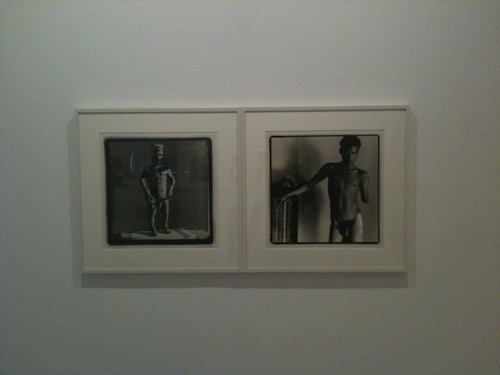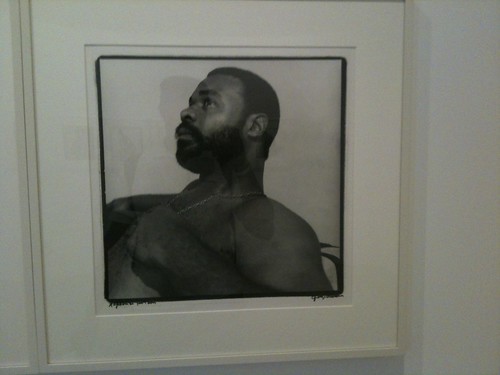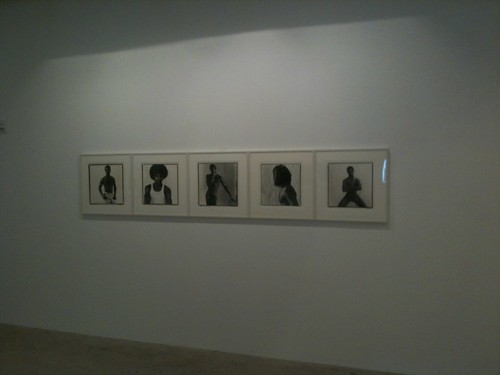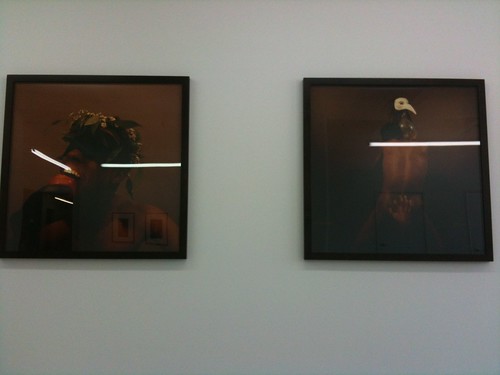 |
| Laurence Patterson, 1970s (© George Dureau, Higher Pictures) |
By splendid coincidence, two exhibits, both quite small but nevertheless impressive, of queer photography from the heyday era of the late 1970s through the mid-1980s are still up in New York City, so yesterday, despite the heat, which turns Manhattan sidewalks into griddles and the subway stations into kilns, I ventured out and over (or under) to catch both.
The first was a tiny exihibit at Higher Pictures gallery, on the Upper East Side, entitled George Dureau Black 1973-1986, totaling only 15 pictures total by the New Orleans-based photographer (1930-), who has been taking photographs for over 50 years, and snapped these as studies for his paintings. All of these were black and white prints from 1973 through 1986, and to my astonishment, it turned out that this is Dureau's first solo exhibit in New York. I'd first seen Dureau's work in book form when I was in my early 20s and working at the old Glad Day Bookshop in Boston, and flipped through it often enough; in that volume, which included many of the images in the show, Dureau creates portraits, suffused with homoeroticism, of young working-class and poor men, some of them with physical challenges.
The portraits bear strong similarities of focus and style with those of Robert Mapplethorpe, but it was Dureau who influenced the younger photographer, who went to New Orleans in the early 1970s to meet and study the senior artist's work, evening restaging them in some cases. Unlike Mapplethorpe's work, Dureau's portraits manage to portray without objectification, possessing a simplicity of composition and manipulation of light and shadow without being simplistic, a casualness of depiction that never feels like happenstance, and an eroticism, even with the nudes, that leaves a great deal to the viewer's imagination. Far more so than Mapplethorpe's work, the subjects of the portraits seem to retain their subjectivity, their individuality, the richness of lives only captured for an instant by the photographer in his studio or on the street. In the gallery's news release, the literary scholar Claude J. Summers describes the difference between the two as "foremost a matter of empathy."
Though we cannot see the milieus from which these men emerge, we can imagine and glimpse them in a way that is not always possible with Mapplethorpe's images. Nevertheless, though Dureau's have documentary power, they represent their subjects as more than indices of a particular time and place; they come alive, as works of art, burning through the moment of their original creation to touch the viewer today. But I don't want to belabor the contrasts; Dureau's pictures speak for themselves. If I have any complain I only wish there were many more on display. Several things I found myself wondering, as I always do when I see such work, is who these men are, what their lives were like, whether they're still around to answer these questions. Dureau's rich images keep me wondering, and thinking.
The exhibit closes on July 13, 2012.


Alphonse Dotson, 1977 (© George Dureau, Higher Pictures)


***
I took the 6 downtown to Union Square and switched over the L to get to Chelsea, where The Walther Collection is featuring the first solo New York show (no less astonishing), Rotimi Fani-Kayode: Nothing to Lose, of the late Nigerian-British photographer (1955-1989) whose work represents some of the most evocative visual cultural production from period in the late 1970s and early 1980s when Black Diasporic queer arts and letters truly emerged. As with Dureau's photographs, I first came across Fani-Kayode's in books, anthologies and journals when I was in my early 20s and he was still alive, and to this day I associate them with the wide array of Black queer art of that moment, but I'd never had the opportunity to see them up close until today, and for that I thank the Walther Collection tremendously. (The exhibit runs until July 28, 2012.)
Gathering a little over a dozen large color and small-scale black-and-white portraits that Fani-Kayode, who was born in Lagos and emigrated with his family to the UK in 1966, after the Nigerian military coup and burgeoning conflict that became the Biafran War, produced during the final years of his life. Fani-Kayode studied at Georgetown University and Pratt Institute, and got to know Robert Mapplethorpe, even drawing upon the latter poet's body of work as he constructed his own.
 |
| © Rotimi Fani-Kayode, The Walther Collection |
If I may quote The Walther Collection's press release,
the photographs on view at The Walther Collection Project Space represent ke works from the series "Nothing to Lose," commissioned as part of the 1989 group exhibition Bodies of Experience: Stories About Living with HIV, which feature primarily portraits and self-portraiture; and from the series "Ecstatic Antibodies," included in the 1990 group exhibition Ecstatic Antibodies: Resisting the AIDS Mythology, which display transformations of the body through the use of masking. In addition, a selection of other black-and-white and color photographs, produced between 1986 and 1989, will also be on view.
The color photographs, some of which have become iconic, depict Fani-Kayode and others in spiritually grounded, ritualistic poses that queer elements of Christian and Yoruba iconography, presenting visual depictions of cultural connection and difference that still feel original, despite the passage of nearly two and half decades and numerous photographers who have taken up his threads. Many present rites that might allow the subject, and the viewer, to transcend the temporal and physical realm; others suggest menace, danger, a choice--as in a bite of a toxic fruit--that might have dire consequences. As the Walther Collection's press release states, they merge Fani-Kayode's "fascination with Yoruba 'techniques of ecstasy' and homoerotic self-expression through symbolic gestures, religion, sexuality, and elaborate decoration." Other motifs that occur in these portraits include exile, death and blackness.
As he was making these images, Fani-Kayode was dealing with HIV/AIDS, and his personal struggle, which mirrored his outspoken public activism regarding the HIV/AIDS pandemic, informs all of these portraits. The bodies here, Fani-Kayode's and others', black, male, queer, even while visually bestilled, often appear to be in motion, transition, in flight, but not away from the horrors of this disease, then at the apogee of its destruction, but toward and against it, in resistance to it, as well as toward zones of possibility, of healing and restoration, of connection of body and spirit, and differing cultural traditions. Rather than depictions of alienation or suffering (which too are here), the images are sites of potentiality, and Fani-Kayode's compositional choices, his use of vibrant color, and his pairing of obvious and more hidden symbols combine to charge each portrait on display.
Yet central to this potentiality and resistance is eros. The eroticized, painted and adorned, partially masked or hidden, anointed and transformed black body, his and other bodies, lose none of their beauty or appeal despite the specter of HIV/AIDS not just hovering over them, but within them. Whereas Mapplethorpe, in hiding a face or focusing on a penis, sometimes slid into objectification, the effect in Fani-Kayode's portraits is synecdochic, and metonymic. The feet or hands or head of hair stand in for the whole body, in the fight of its life and facing down death, the whole body pointing to and standing alongside all the other black male and queer bodies that HIV/AIDS would carry away from this human realm. The spiritual nature of Fani-Kayode's portraiture then is especially important, because it suggests he was in touch with other worlds, that his subjects might, even if leaving this world, would be prepared for other ones.
One final note: the gallery had several books for sale, including one featuring the work of Fani-Kayode and his late partner Alex Hirst, and while flipping through it I came across a number of Fani-Kayode's portraits featuring writers and artists I knew many years ago, among them the writer and scholar Guy-Mark Foster; one of the images I stopped on was titled "The Kiss" (or perhaps it was "Kiss"), featuring two beautiful young black men embracing, one cradling the other, about to kiss. I noted to the young gallery attendant that the two people in the photo were Essex Hemphill and Isaac Julien, two figures who played key roles in the emergence of Black Diasporic queer art. (He asked who Hemphill was, but certainly knew Julian.) For me, the image, like the others in the show, threaded the needle in terms of demonstrating that Fani-Kayode was and is another such figure. It also underlines his centrality to an era now gone, but captured in the literature and films and images that thankfully endure.










No comments:
Post a Comment